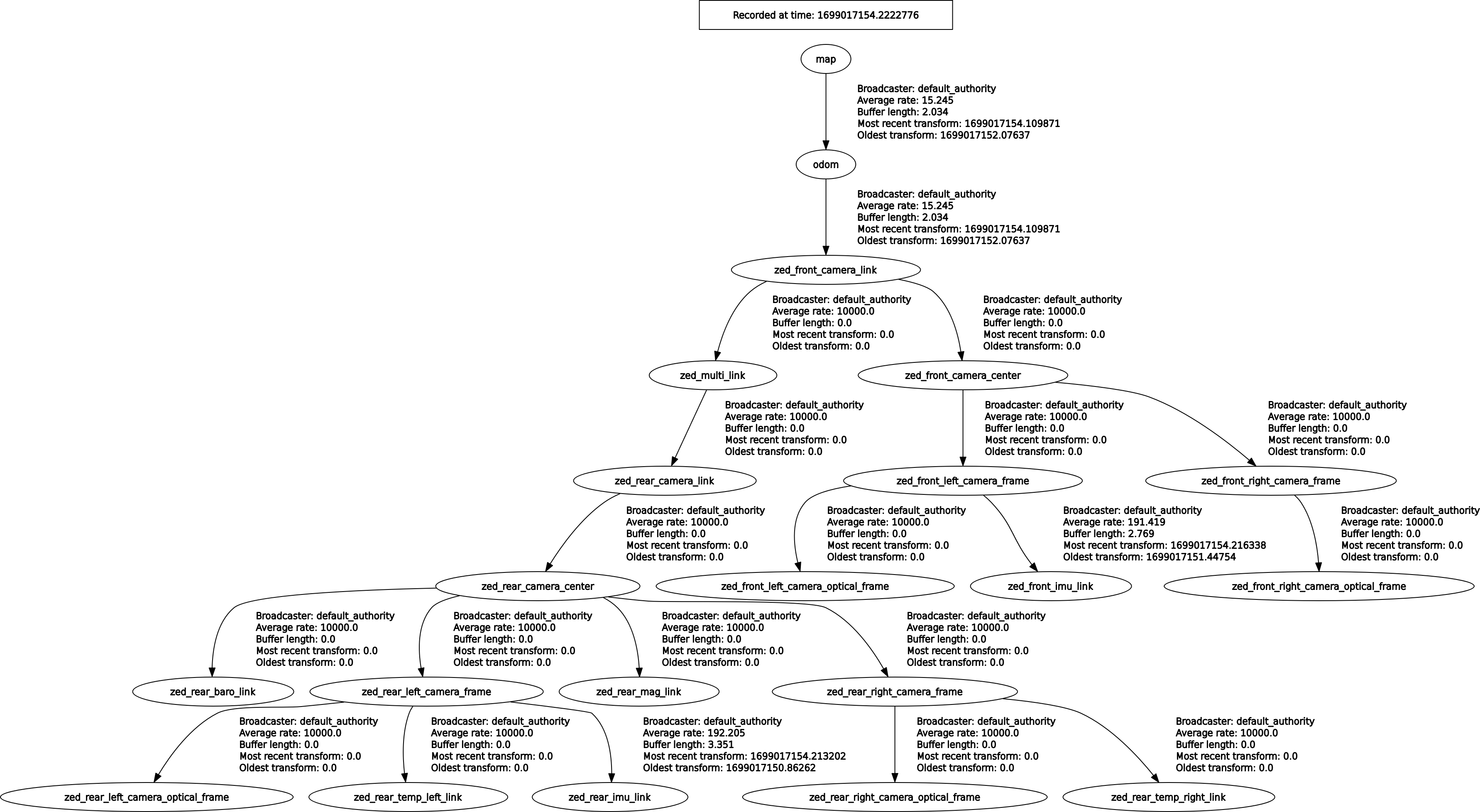Package Summary
| Tags | No category tags. |
| Version | 5.0.0 |
| License | Apache License 2.0 |
| Build type | AMENT_CMAKE |
| Use | RECOMMENDED |
Repository Summary
| Description | A collection of examples and tutorials to illustrate how to better use the ZED cameras in the ROS2 framework |
| Checkout URI | https://github.com/stereolabs/zed-ros2-examples.git |
| VCS Type | git |
| VCS Version | master |
| Last Updated | 2025-05-14 |
| Dev Status | UNMAINTAINED |
| CI status | No Continuous Integration |
| Released | UNRELEASED |
| Tags | examples tutorials zed ros2 rviz-plugins |
| Contributing |
Help Wanted (0)
Good First Issues (0) Pull Requests to Review (0) |
Package Description
Additional Links
Maintainers
- STEREOLABS
Authors
Multi camera tutorial
In this tutorial you will learn how to create a multi-camera configuration with ZED devices.
For a multi-camera configuration it is important to correctly identify each camera in the system by using its serial number and precisely set the position and the orientation of each of them with respect to a reference point.
The launch file explained
The example launch file zed_multi_camera.launch.py allows to dynamically configure a robotics system equipped with multiple different models of ZED cameras.
The launch file starts a Robot State Publisher node that defines the position and orientation of each camera in the multi-camera system, a Robot State Publisher node for each camera that broadcast all the static frames of the camera, and a ZED node for each camera.
The number of ZED nodes to start is infered by the size of the parameters passed to the launch file from the command line.
All the ZED nodes are loaded in the same ROS 2 container using Composition. It is possible to load other ROS 2 components in the same container to leverage zero copy Intra-Process Communication (IPC).
You can retrieve the name of the container and check the components that are running in the same process by using the command
ros2 component list
for example:
$ ros2 component list
/zed_multi/zed_multi_container
1 /zed_multi/zedx_front
2 /zed_multi/zedx_rear
:pushpin: Note: All the nodes run in the same namespace
zed_multi.
Launch parameters
All the parameter arrays must have the same size:
-
cam_names: {REQUIRED} An array containing the name of the cameras, e.g.'[zed_front,zed_back]'. Note: It is important that all the cameras have a different name to correctly distinguish them. -
cam_models: {REQUIRED} An array containing the model of the cameras, e.g.'[zed2i,zed2]' -
cam_serials: An array containing the serial number of the cameras, e.g.[3001234,2001234] -
cam_ids: An array containing the ID number of the cameras, e.g.[0,1] -
disable_tf: Only the first camera is configured to broadcast the TFmap->odom->camera_linkto avoid TF conflicts. The TF broadcasting can be disabled by setting this parameter tofalse. This is required if an external Kalman filter that fuses different odometry sources is used.
:pushpin: Note: One of
cam_serialsorcam_idsargument is required to uniquely identify the cameras of the system.
Run the example
Launch the dual camera nodes by using the following command
ros2 launch zed_multi_camera zed_multi_camera.launch.py cam_names:='[zed_front,zed_back]' cam_models:='[zed2i,zed2]' cam_serials:='[31234567,21234567]'
Info: To retrieve the serial number of each connected camera you can use the command $ ZED_Explorer --all.
Note: The parameters cam_models and cam_serials must be modified according to the configuration of your system.
Example with serial numbers:
ros2 launch zed_multi_camera zed_multi_camera.launch.py cam_names:='[zed_front,zed_back]' cam_models:='[<front_camera_model>,<rear_camera_model>]' cam_serials:='[<front_camera_serial>,<rear_camera_serial>]'
Example with ID numbers:
ros2 launch zed_multi_camera zed_multi_camera.launch.py cam_names:='[zed_front,zed_back]' cam_models:='[<front_camera_model>,<rear_camera_model>]' cam_ids:='[<front_camera_id>,<rear_camera_id>]'
:pushpin: Note: For multi-GMSL2 camera setups, it’s advisable to use camera IDs rather than Serial Numbers. Each camera ID linked to a GMSL2 wire remains consistent during reboots, unlike USB3 cameras, which may change.
The Multi-Camera URDF
It is important to create a URDF that defines the position of all the cameras with respect to a reference link.
We provide an example in ‘urdf/zed_multi.urdf.xacro’.
The URDF is created by using the ‘xacro’ tool.
First of all all reference links are created:
<link name="$(arg multi_link)" />
<link name="$(arg camera_name_0)_camera_link" />
<link name="$(arg camera_name_1)_camera_link" />
The name of the reference link is contained in the xacro argument multi_link, the default value is zed_multi_link.
A “virtual” link camera_link for each camera must be defined to correctly connect the URDF of each camera to the reference link.
Next, a joint to connect the reference link to the main link of each camera is created:
<joint name="$(arg camera_name_0)_camera_joint" type="fixed">
<parent link="$(arg camera_name_0)_camera_link"/>
<child link="$(arg multi_link)"/>
<origin xyz="0.06 0.0 0.0" rpy="0 0 0" />
</joint>
<joint name="$(arg camera_name_1)_camera_joint" type="fixed">
<parent link="$(arg multi_link)"/>
<child link="$(arg camera_name_1)_camera_link"/>
<origin xyz="-0.06 0.0 0.0" rpy="0 0 ${M_PI}" />
</joint>
The name of the joint is created from the variable camera_name_x that identifies the name of each camera.
A position and orientation must be provided for each camera with respect to the main link:
<origin xyz="x y z" rpy="r p y" />
the position is in meters, the orientation in radians.
Important: The first joint has parent link and child link inverted with respect to all the other joints. This is required because
the first camera is the reference for visual odometry processing and in ROS a joint cannot have two parents.
The following image displays the TF tree generated for the dual camera configuration of this tutorial:

Wiki Tutorials
Package Dependencies
| Deps | Name |
|---|---|
| ament_cmake_auto | |
| ament_cmake | |
| ament_lint_auto | |
| ament_lint_common | |
| ament_cmake_clang_format | |
| zed_wrapper |
System Dependencies
Dependant Packages
| Name | Deps |
|---|---|
| zed_ipc |
